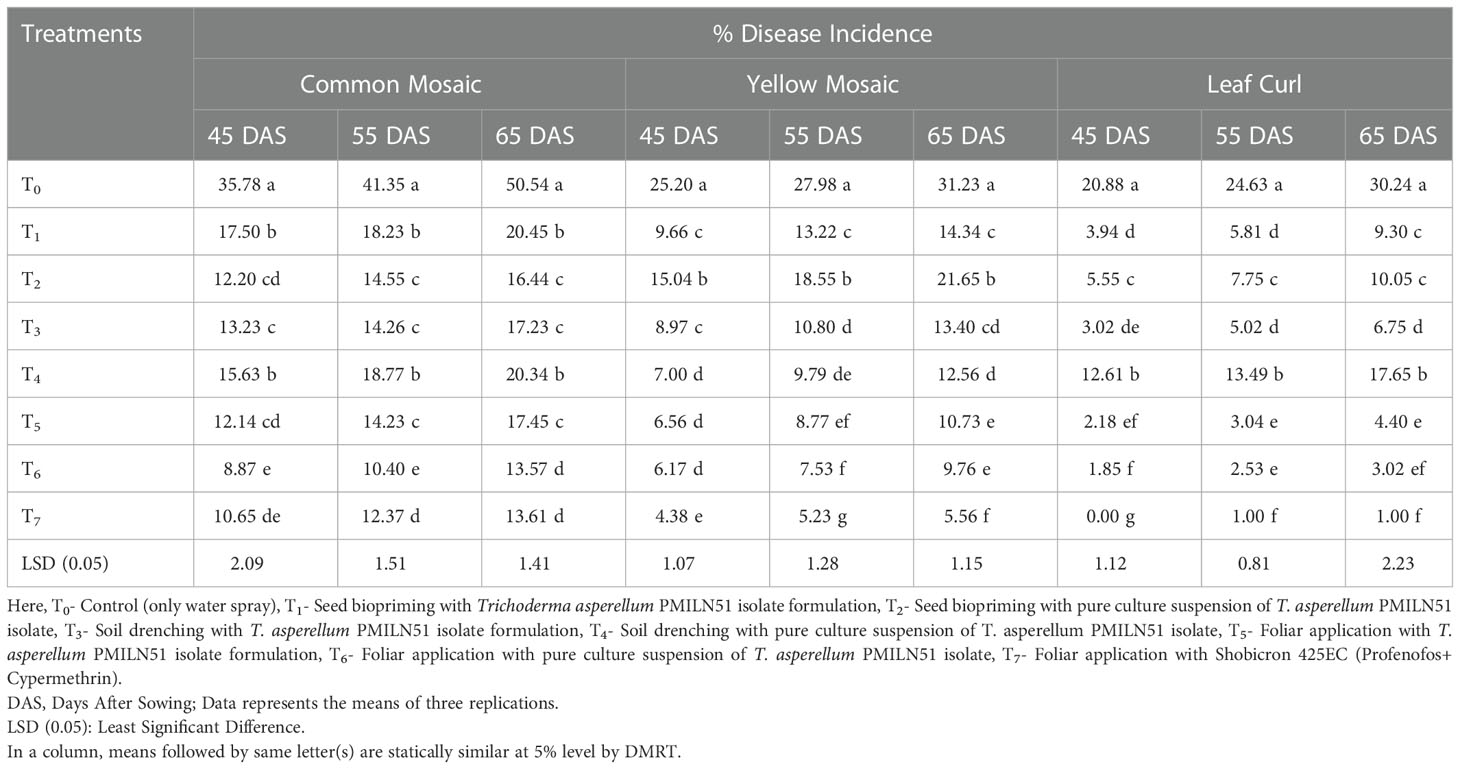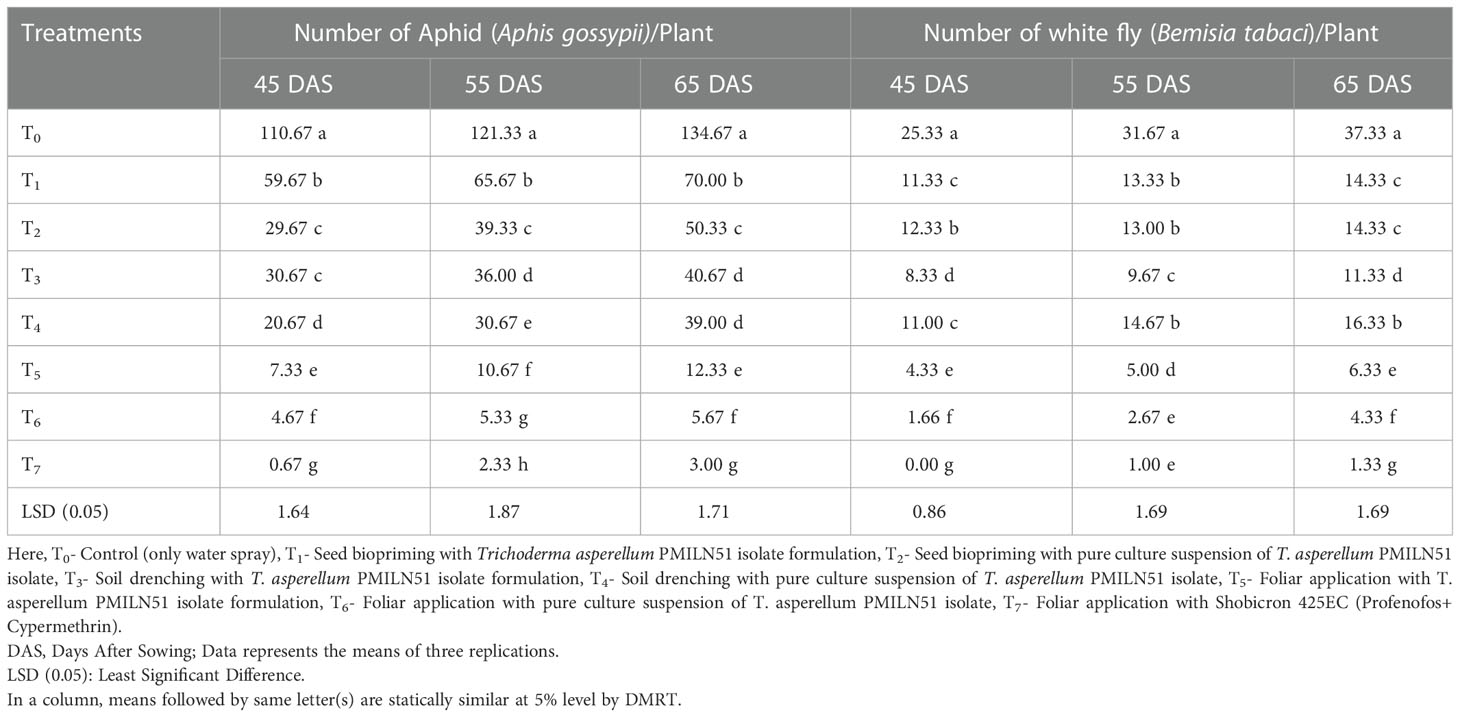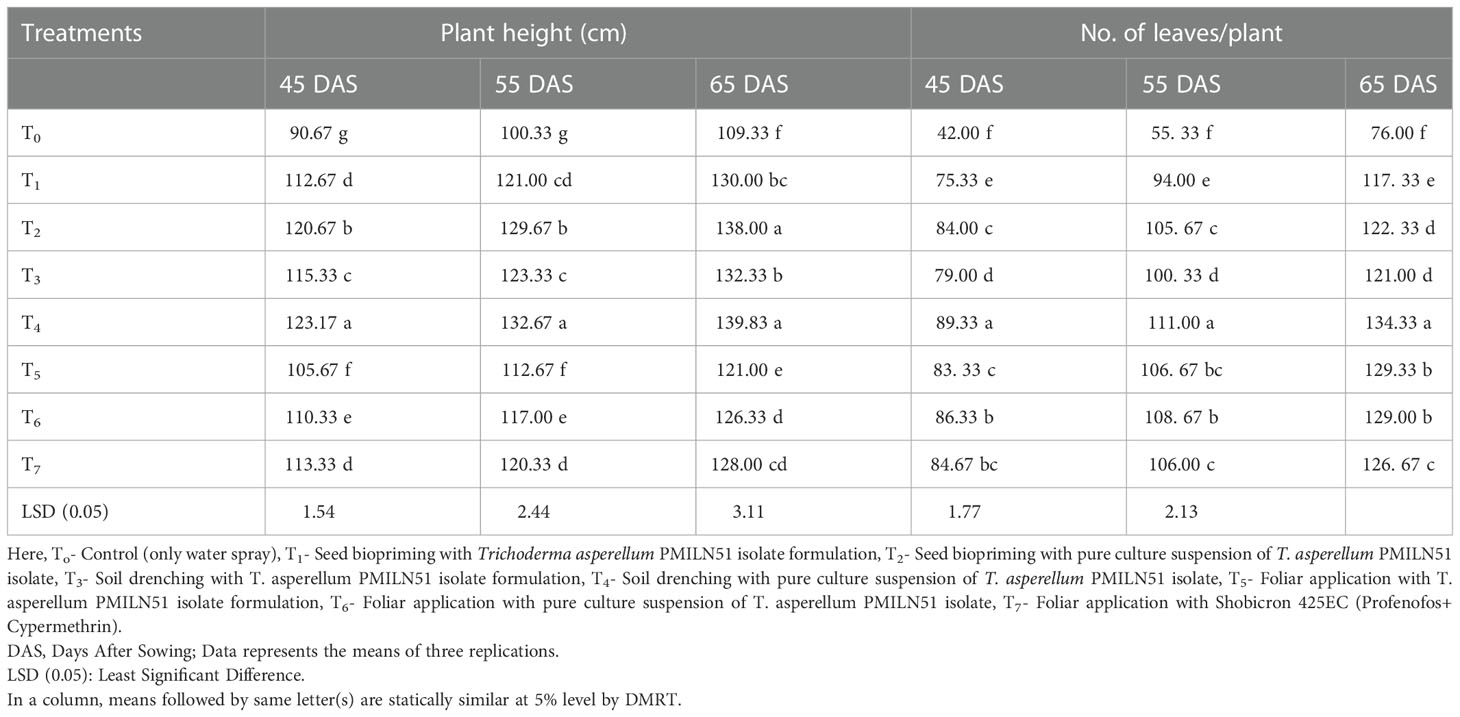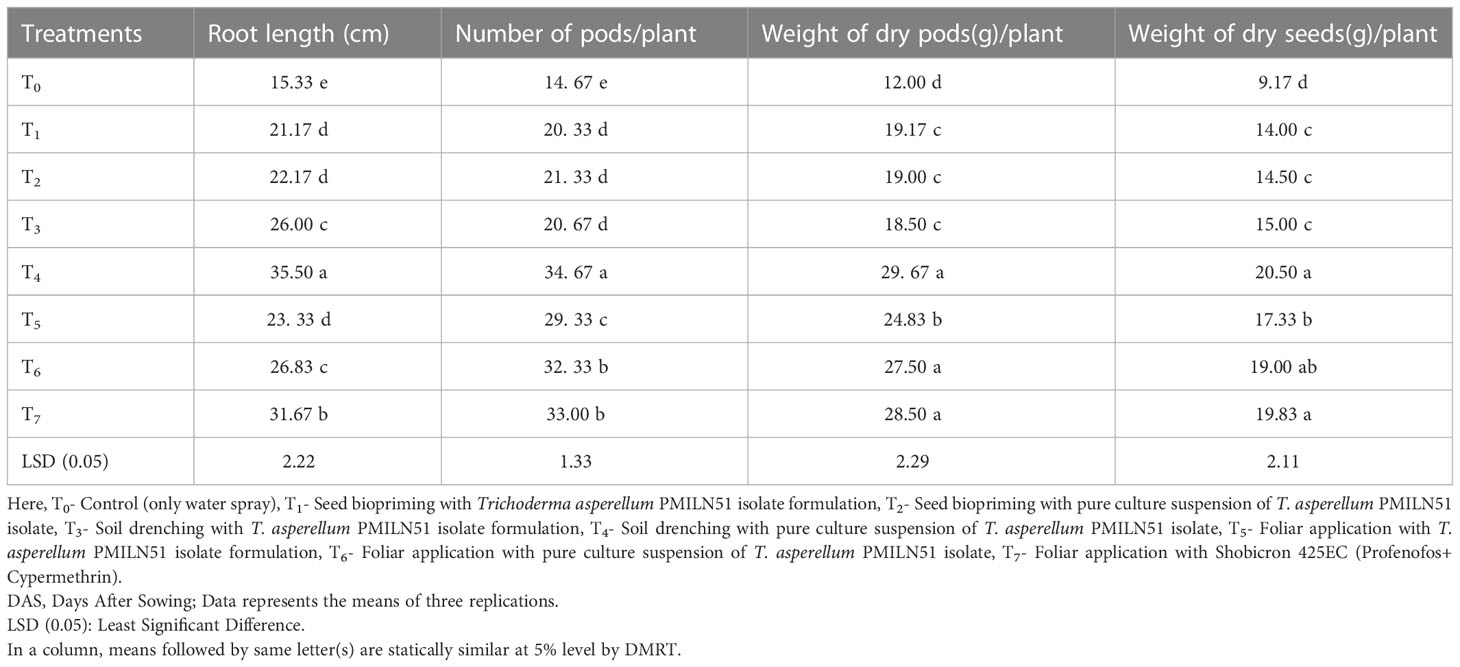- 1Plant Microbe Interaction Laboratory, Department of Plant Pathology, Bangladesh Agricultural University, Mymensingh, Bangladesh
- 2Virology, Translational Plant Pathology and Agrosecurity Laboratory, Department of Plant Pathology, Bangladesh Agricultural University, Mymensingh, Bangladesh
Viral diseases are the main adversaries of country bean (Lablab purpureus Lin.) production in Bangladesh. Potyviruses and cucumber mosaic virus (CMV) have been reported in country bean leaves that displayed virus-like symptoms. This study looked at the growth and yield of country bean plants that had been treated with Trichoderma asperellum to control country bean viruses. T. asperellum-treated plants exhibited decreased disease incidence up to 91% and a drop in the vector population up to 96%, when compared to control plants. Plant growth was enhanced in soil drenched with T. asperellum suspension, with an increase in the number of leaves per plant, pods per plant, root length, weight of dried pods/plant, and weight of dried seeds/plant. Finally, our findings suggest that T. asperellum could be an effective treatment for controlling viral diseases of the country bean in Bangladesh.
Introduction
Country bean (Lablab purpureus Lin.), a member of the Leguminosae family and the Papilionaceae subfamily, is regarded as an economically significant pulse crop or vegetable in Bangladesh (Biddle and Cattlin, 2007; Jayasinghe et al., 2015). This is primarily grown in almost all districts of Bangladesh during the winter season (Chowdhury et al., 1989; Sibiko et al., 2013; Bangladesh Bureau of Statistics (BBS), 2020). The bean crop improves soil fertility by establishing a symbiotic relationship with rhizobium bacteria in order to fix atmospheric nitrogen (Karla, 2009). Country bean seeds and pods are edible and high in protein, carbohydrates, essential nutrients, and vitamins, while the rest of the foliage is used as fodder. As a result, it has a significant nutritional impact on both rural and urban Bangladeshis (Rehana, 2006).
Viruses cause serious threats to bean crop production in Bangladesh (Akhter et al., 2019). These viruses can be transmitted through seeds, nematodes, and insects (Hema et al., 2014). Potyviruses such as bean common mosaic virus (BCMV) and bean common mosaic necrosis virus (BCNMV) cause “common mosaic” symptoms in bean plants, which are also associated with symptoms such as green vein banding and leaf deformity, as well as systemic necrosis and plant mortality (Morales, 2003; Schwartz et al., 2005). Another potyvirus, Bean Yellow Mosaic Virus (BYMV), reduces photosynthesis by reducing pigment content in leaves, causing severe mosaic, mottling, and crinkling, as well as size reduction (Mojca et al., 2001; Miteva et al., 2005). CMV causes symptoms in bean plants that range from minor mosaic in the leaves to severe plant deformity, with 5% to 75% production losses (Morales, 2003; Schwartz et al., 2005). Various serological and molecular methods are used for detecting viruses in bean plants. For example, immunostrips are used in the field to detect potyviruses and CMV in a quick, easy, and practical manner (Chiemsombat et al., 2014).
In Bangladesh, field control of viral diseases in bean plants is difficult due to a lack of direct chemical therapies and effective resistance cultivars. Therefore, the integration of traditional control measures such as cultural management, vector control, and the use of virus-free planting material is encouraged to deal with viral diseases in country beans (Akhter et al., 2019). Biological control agents, such as Trichoderma spp., on the other hand, have been shown to have the potential to inhibit viral diseases by inducing plant defense responses such as systemic resistance against pathogenic viruses, as well as to improve plant growth and development (Harman, 2006; McLean et al., 2012; Vitti et al., 2015). Trichodermin, a trichoderma product, has antagonistic properties and promotes plant germination, seedling emergence, height, weight, and yield (Tverdyukov et al., 1994). Bhardwaj and Kumar (2017) found volatile secondary metabolites in T. asperellum culture filtrate with diverse actions ranging from anti-pathogenic to plant growth stimulation. Thus, the purpose of this research is to find out the effectiveness of the T. asperellum PMILN51 isolate in controlling viral diseases and promoting the growth and yield of country bean.
Materials and methods
The current study looked at the efficacy of a T. asperellum PMILN51 isolate in suppressing viral diseases of country beans and promoting growth and yield. The research was conducted between November 2019 and March 2020 at the Seed Pathology Centre (SPC) and Plant-Microbe Interaction Laboratory (PMIL), Department of Plant Pathology, Bangladesh Agricultural University, Mymensingh. Sheem Kartika, a high-yielding native variety of country bean in Bangladesh, was used in the pot experiments. The plastic pots in the experiments were filled with 5 kg of 4% formalin-treated soil mix. Twenty-four pots were prepared for eight treatments, including the control, and each treatment was replicated three times. On November 4, 2019, ten seeds were sown in each container. To maintain the optimal plant population (3 plants/pot), thinning was performed 21 days after sowing (DAS). Fertilizers were administered to each pot according to the Fertilizer Recommendation Guide’s suggested dose (BARC (Bangladesh Agricultural Research Council), 2012). Weeding and irrigation were done on a regular basis in all of the pots as needed. Treatments listed in Table 1 were used to assess the impact of the T. asperellum PMILN51 isolate on the incidence and severity of country bean viral infections, as well as the growth and yield contributing features of country beans. Pure culture suspension and formulation of T. asperellum PMILN51 isolate,with strong antagonistic activity were prepared as reported previously (Islam, 2018) and used for biopriming, foliar spray, and soil soaking (Vitti et al., 2016).
The incidence of country bean viral diseases was determined in each pot (Degu et al., 2020) using following formula –
In this study, potyvirus and cucumber mosaic virus (CMV) detecting immunostrips (Agdia, USA; www.agdia.com) were used to check the presence of potyvirus and CMV following manufacturer instructions. Insect population densities were visually counted from each pot (Alao et al., 2017). Plant height (cm), number of healthy leaves per plant, total number of pods per plant, total quantity of seeds per plant, root length (cm) after harvest, dry pod weight (g) per plant, and dry seed weight (g) per plant were all measured in both healthy and diseased plants. The experiment was carried out in a completely randomized design with three replications. The data on various parameters were statistically analyzed using the Analysis of Variance (ANOVA) technique to determine the degree of significance (Gomez and Gomez, 1984). Duncan Multiple Range Test (DMRT) was used to compare the treatment means at a 5% level of significance. SAS (University Edition version 3.71, basic edition) was used to analyze the obtained data.
Results and discussion
T. asperellum is an effective biocontrol agent that boosts plant defence mechanisms against viral infection (Elsharkawy et al., 2013). The current study found that spraying country bean plants with a foliar application of a pure culture suspension of T. asperellum PMILN51 isolate (T6) reduced incidence of viral diseases in country bean plants. In the control plants, symptoms of three different diseases: common mosaic, yellow mosaic, and leaf curl were detected (Table 1). On the infected country bean leaves, insect vectors such as aphids (Aphis gossypii) and whiteflies (Bemisia tabaci) were also observed (Table 2). The lowest incidences of common mosaic disease were found in T6 at 45 DAS (8.87%), 55 DAS (10.40%), and 65 DAS (13.57%), respectively (Table 1). Country bean leaf samples with typical mosaic symptoms tested positive for both potyvirus and CMV. According to Li et al. (2015), an increasing number of tricho-suspension sprays produce a higher concentration of trichodermin, which improves plant growth and the plant’s immune defense mechanism against pathogens. We observed the occurrence of yellow mosaic disease in bean plants in this study, and interestingly, all treated plants with trichoderma or insecticides had a reduced incidence of yellow mosaic disease from 4.38% to 21.65% (Table 1). Plants treated with foliar application of pure culture suspension of T. asperellum (T6) had the lowest yellow mosaic disease incidence rates of 6.17 percent, 7.53 percent, and 9.76 percent, respectively, at 45 DAS, 55 DAS, and 65 DAS (Table 1), followed by T5 (foliar application with formulated T. asperellum). However, at 45 DAS, 55 DAS, and 65 DAS, control plants had the highest yellow mosaic incidence of 25.20 percent, 27.98 percent, and 31.23 percent, respectively (Table 1). Country bean plants with yellowing symptoms, on the other hand, exhibited a positive reaction solely to the CMV detecting immunostrip and a negative reaction to the potyvirus detecting immunostrip. Besides, common mosaic disease and bean yellow mosaic disease symptoms, bean plants in this study also showed leaf curl disease symptom. In agreement with the reduction of common mosaic disease and bean yellow mosaic disease, treatment T6 also lowered the incidence of leaf curl disease at 45 DAS, 55 DAS, and 65 DAS, respectively (Table 1), followed by T5. Reduction of diseases by trichoderma-based treatment could be due to trichodermin-produced sesquiterpene antibiotics that bind to viral proteins and that inhibit protein synthesis of potyviruses, CMV, or other viruses. According to Elsharkawy et al. (2013), T. asperellum is an effective biocontrol agent that boosts plant defence mechanisms against viral infection. Harman et al. (2004) reported that several Trichoderma species added to the rhizosphere protect plants against a wide range of plant pathogens, including viral, bacterial, and fungal pathogens, indicating the induction of resistance mechanisms similar to the hypersensitive response (HR), systemic acquired resistance (SAR), and induced systemic resistance (ISR) in plants.
The vector population, such as the number of aphids and whiteflies, was reduced in T. asperellum PMILN51 isolate sprayed plants (T6 and T5) compared to other trichoderma-treated plants and non-treated controls in the current study (Table 2) . This is consistent with previous findings in which Trichoderma acts as an entomopathogen directly through parasitism and the production of insecticidal secondary metabolites, antifeedant compounds, and repellent metabolites (Poveda et al., 2020). Trichoderma can effectively parasitize insect bodies, using them as a source of nutrients for the formation of new conidia. Trichoderma produces many volatile compounds that can act as insect repellents, according to Siddique et al. (2011). Insecticides like Shobicron 425EC (Profenofos + Cypermethrin) are harmful to the environment. So, eco-friendly T. asperellum PMILN51 isolate could be a viable alternative to chemical treatment. However, further experiments need to be carried out in order to assess the field efficacy in controlling viral diseases of country bean plants with T. asperellum PMILN51 isolate and to conduct metabolic and gene expression studies in order to understand the resistance mechanism of T. asperellum PMIL-N51 isolate sprayed plants.
In this study, soil drenched with a pure culture suspension of T. asperellum PMILN51 isolate (T4) showed higher plant growth and increased numbers of leaves/plant, pods/plant, root length, weight of dry pods/plant and weight of dry seeds/plant compared to other treatments, including control plants (Tables 3, 4). Trichoderma spp., according to Pereira et al. (2014), can promote common bean plant growth by increasing root as well as foliar areas and size when compared to plants grown without it. Yedidia et al. (2001) reported a much stronger effect on cucumber plants treated with Trichoderma spp, which increased by 75% the length of the root, 95% aerial parts, 80% dry weight,and 80% the size of the blade relative to the untreated control. Abd-El-Khair et al. (2010) found that the average fresh weight of pods in beans was increased in the case of Trichoderma treatment, compared to the control plant. In this study, the yield of country beans was higher in Trichoderma treated plants than in non-treated plants. Hoyos-Carvajal et al. (2009) found that the ability of Trichoderma spp. to promote plant growth was initially attributed to its antagonistic activity against harmful microorganisms living in the rhizosphere or soil. Vitti et al. (2015) found that Trichoderma performs mycoparasitism, competition for nutrients with other pathogens, the release of extracellular hydrolytic enzymes, antagonism against plant pathogens, colonization of the rhizosphere and phyllosphere, production of secondary metabolites that are toxic to plant pathogens, promotion of plant growth and root development, and induction of systemic resistance against different pathogens.
All this information supports the findings of this study, which recorded lower disease incidence and greater growth and yield contributing parameters in Trichoderma treated plants. The use of Trichoderma spp. as bio-control agents induced the accumulation of some enzymes such as chitinase, peroxidase, and polyphenol oxidase, which play an important role in plant defence mechanisms against pathogen infection, and the enzymatic activity in treated bean plants increased more than in untreated ones. Peroxidase and resistance development in plants have positive relationships, and peroxidase has been shown in experiments to play a defensive role against invading pathogens (Caruso et al., 2001; Nawar and Kuti, 2003).
Data availability statement
The original contributions presented in the study are included in the article/supplementary material. Further inquiries can be directed to the corresponding authors.
Author contributions
All authors contributed to the conception and design of the manuscript. The first draft of the manuscript was written by IH and all authors commented on submitted version of the manuscript. All authors contributed to the article and approved the submitted version.
Acknowledgments
This research was funded by the University Grants Commission of Bangladesh (UGC) under the project number 2020/4/UGC provided by Bangladesh Agricultural University Research System (BAURES). Fariha Tanjum Swarna received the National Science and Technology (NST) Fellowship.
Conflict of interest
The authors declare that the research was conducted in the absence of any commercial or financial relationships that could be construed as a potential conflict of interest.
Publisher’s note
All claims expressed in this article are solely those of the authors and do not necessarily represent those of their affiliated organizations, or those of the publisher, the editors and the reviewers. Any product that may be evaluated in this article, or claim that may be made by its manufacturer, is not guaranteed or endorsed by the publisher.
References
Abd-El-Khair H., Khalifa R. K. M., Haggag K. H. (2010). Effect of trichoderma species on damping off diseases incidence, some plant enzymes activity and NutritionalStatus of bean plants. J. Am. Sci. 6 (9), 486–497.
Akhter M. S., Akanda A. M., Kobayashi K., Jain R. K., Mandal B. (2019). Plant virus diseases and their management in Bangladesh. Crop Prot. 118, 57–65. doi: 10.1016/j.cropro.2018.11.023
Alao F. O., Adebayo T. A., Odewole A. F., Oluwasey O. (2017). Comparative assessment of insect pests population densities of three selected cucurbit crops. Acta fytotechn zootechn 20 (4), 78–83. doi: 10.15414/afz.2017.20.04.78-83
Bangladesh Bureau of Statistics(BBS) (2020). Year book of agricultural statistics of Bangladesh 2019. 31st edition (Dhaka, Bangladesh: Ministry of Planning. Government of the People’s Republic of Bangladesh).
Bhardwaj N. R., Kumar J. (2017). Characterization of volatile secondary metabolites from trichoderma asperellum. J. Appl. Natural Sci. 9 (2), 954–959. doi: 10.31018/jans.v9i2.1303
Biddle J. A., Cattlin N. (2007). Pests, diseases and disorders of peas and beans. CRC Press. doi: 10.1201/b15137
Caruso C., Chilosi G., Leonard L., Bertin L., Magro P., Buonocore V. (2001). A basic peroxidase from wheat kernel with antifungal activity. Phytochemstry 72, 248–254. doi: 10.1016/S0031-9422(01)00226-6
Chiemsombat P., Prammanee S., Pipattanawong N. (2014). Occurrence of telosma mosaic virus causing passion fruit severe mosaic disease in Thailand and immunostrip test for rapid virus detection. Crop Prot. 63, 41–47. doi: 10.1016/j.cropro.2014.04.023
Chowdhury A. R., Ali M., Quadir M. N. A., Talukder M. H. (1989). Floral biology of country bean (Lablab purpureas l. sweet). Thai J. Agric. Sci. 22, 56–67.
Degu T., Yaregal W., Gudisa T. (2020). Status of common bean (Phaseolus vulgaris l.) diseases in metekel zone, north West Ethiopia. J. Plant Pathol. Microbiol. 11, 494. doi: 10.35248/2157-7471.20.11.494
Elsharkawy M. M., Shimizu M., Takahashi H., Ozaki K., Hyakumachi M. (2013). Induction of systemic resistance against cucumber mosaic virus in arabidopsis thaliana by Trichoderma asperellum SKT-1. Plant Pathol. J. 29 (2), 193–200. doi: 10.5423/PPJ.SI
Gomez K. A., Gomez A. A. (1984). Statistical procedures for agricultural research. 2nd Edn (New York: John Willey and Sons), 97–111.
Harman G. E. (2006). Overview of mechanisms and uses of trichoderma spp. Phytopathology 96, 190–194. doi: 10.1094/PHYTO-96-0190
Harman G. E., Howell C. R., Viterbo A., Chet I., Lorito M. (2004). Trichoderma species–opportunistic, avirulent plant symbionts. Nat. Rev. Microbiol. 2, 43–56. doi: 10.1038/nrmicro797
Hema M., Sreenivasulu P., Patil B. L., Kumar P. L., Reddy D. V. R. (2014). Tropical food legumes. Adv. Virus Res., 431–505. doi: 10.1016/b978-0-12-801246-8.00009-3
Hoyos-Carvajal L., Orduz S., Bissett J. (2009). Genetic and metabolic biodiversity of trichoderma from Colombia and adjacent neotropic regions. Fungal Genet. Biol. 46, 615–631. doi: 10.1016/j.fgb.2009.04.006
Islam M. Z. (2018). Eco-friendly management of alternaria leaf spot of mustard (Mymensingh-2202: Department of Plant Pathology, Bangladesh Agricultural University).
Jayasinghe R. C., Premachandra W. T. S. D., Neilson R. (2015). A study on marucavitrata infestation of yard-long beans (Vigna unguiculata subspecies sesquipedalis). Heliyon 1 (1), e00014. doi: 10.1016/j.heliyon.e00014
Karla V. K. (2009). Integrated control of the pest complex of mustard (India: Department of Entomology, Haryana Agricultural University), 17–19.
Li C. W., Song R. Q., Yang L. B., Deng X. (2015). Isolation, purification and structural identification of an antifungal compound from a trichoderma strsin. J. Microbial Biotechnol. 25 (8), 1257–1264. doi: 10.4014/jmb.1410.10027
McLean K. L., Hunt J. S., Stewart A., Wite D., Porter I. J., Villalta O. (2012). Compatibility of a trichoderma atroviride biocontrol agent with management practices of allium crops. Crop Prot 33, 94–100. doi: 10.1016/j.cropro.2011.11.018
Miteva E., Hristova A. D., Nenova B. V., Maneva S. (2005). Arsenic as a factor affecting virus infection in tomato plants: changes in plant growth, peroxidase activity and chloroplast pigments. Sci. Horticult 105, 343–358. doi: 10.1016/j.scienta.2005.01.026
Mojca M., Maja R., Maja K. (2001). Peroxidases and photosynthetic pigments in susceptible potato infected with potato virus YNTN. Plant PhysiolBiochem 39, 891–898. doi: 10.1016/S0981-9428(01)01303-1
Morales F. J. (2003). “Common bean,” in Virus andvirus-like diseases of major crops in developing countries. Eds. Loebenstein G., Thottappilly G. (The Netherlands: Kluwer Academic Publishers), 425–445).
Nawar H. F., Kuti J. D. (2003). Wyerone acid phytoalexin synthesis and peroxidase activity as markers for resistance of broad bean to chocolate spot disease. J. Phytopathol. 151, 564–570. doi: 10.1046/j.1439-0434.2003.00732.x
Pereira J. L., Queiroz R. M. L., Charneau S. O., Felix C. R., Ricart C. A. O. (2014). Analysis of Phaseolus vulgarisResponse to its association with Trichoderma harzianum(ALL-42) in the presence or absence of the phytopathogenic fungi rhizoctoniasolani and Fusarium solani. PloS One 9 (5), e98234. doi: 10.1371/journal.pone.0098234
Poveda J., Abril-Urias P., Escobar C. (2020). Biological control of plant-parasiticnematodes by filamentous fungi inducers of resistance: Trichoderma, mycorrhizal and endophytic fungi. Front. Microbiol. 11, 992. doi: 10.3389/fmicb.2020.00992
Rehana M. J. (2006). Effects of phosphorous and mulching on the growth and yield of French bean (Mymensingh-2202: Department of Horticulture, Bangladesh Agricultural University), 1–92.
Schwartz H. F., Steadman J. R., Hall R., Foster R. L. (2005). Compendium of bean diseases. 2nd ed (St. Paul, MN, USA: American Phytopathological Society).
Sibiko K. W., Ayuya O. I., Gido E. O., Mwangi J. K. (2013). An analysis of economic efficiency in bean production: evidence from eastern Uganda. J. Economics Sustain. Dev. 4 (13), 1–10.
Siddique S., Cheong B. E., Taslima K., Kausar H., Hasan M. M. (2011). Separation and identification of volatile compounds from liquid cultures Trichoderma harzianumby GC-MS using three different capillary columns. J. Chromatogr. Sci. 50, 358–367. doi: 10.1093/chromsci/bms012
Tverdyukov A. P., Nikonov P. V., Yushchenko N. P. (1994). Trichoderma. Rev. Plant Pathol. 73 (4), 237.
Vitti A., La Monaca E., Sofo A., Scopa A., Cuypers A., Nuzzaci M. (2015). Beneficial effects of Trichoderma harzianumT-22 in tomato seedlings infected by Cucumber mosaic virus (CMV). BioControl 60 (1), 135–147. doi: 10.1007/s10526-014-9626-3
Vitti A., Pellegrini E., Nali C., Lovelli S., Sofo A., Valerio M., et al. (2016). Trichoderma harzianum T-22 induces systemic resistance in tomato infected by cucumber mosaic virus. Front. Plant Sci. 7. doi: 10.3389/fpls.2016.01520
Keywords: bio-control, diseases, bean, ecofriendly management, virus
Citation: Ali Hossain M, Tanjum Swarna F, Al Arabi R and Hamim I (2023) Trichoderma asperellum suppresses viral diseases and promotes the growth and yield of country bean. Front. Agron. 5:1150359. doi: 10.3389/fagro.2023.1150359
Received: 24 January 2023; Accepted: 02 May 2023;
Published: 06 June 2023.
Edited by:
Milan Kumar Lal, Central Potato Research Institute (ICAR), IndiaReviewed by:
Ho-jong Ju, Jeonbuk National University, Republic of KoreaMamunur Rashid, Bangladesh Rice Research Institute, Bangladesh
Abu Noman Faruq Ahmmed, Sher-e-Bangla Agricultural University, Bangladesh
Copyright © 2023 Ali Hossain, Tanjum Swarna, Al Arabi and Hamim. This is an open-access article distributed under the terms of the Creative Commons Attribution License (CC BY). The use, distribution or reproduction in other forums is permitted, provided the original author(s) and the copyright owner(s) are credited and that the original publication in this journal is cited, in accordance with accepted academic practice. No use, distribution or reproduction is permitted which does not comply with these terms.
*Correspondence: Islam Hamim, aGFtaW1wcGF0aEBiYXUuZWR1LmJk; Muhammed Ali Hossain, YWxpaG9zc2Fpbi5wcGF0aEBiYXUuZWR1LmJk
 Muhammed Ali Hossain1*
Muhammed Ali Hossain1* Islam Hamim
Islam Hamim


